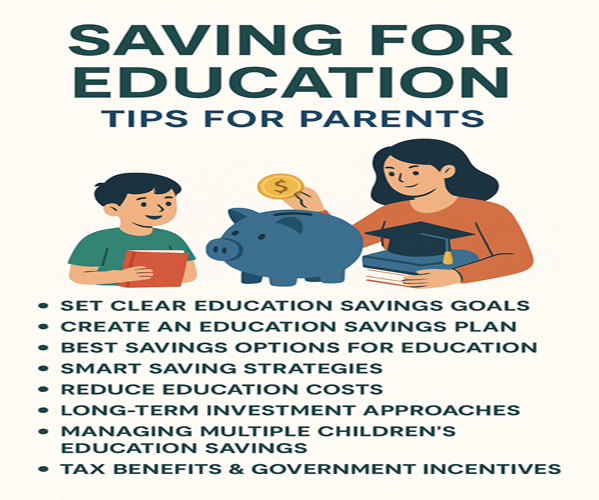Introduction
Education is one of the most valuable investments parents can make in their children’s future. Whether it’s preschool, private school, college, or advanced professional training, education comes with significant costs. The challenge many families face is balancing current household expenses with saving enough for future education needs. Without proper planning, tuition fees, books, and living expenses can create financial stress.
The good news is that parents can ease this burden by starting early, choosing the right savings strategies, and following disciplined financial planning. In this comprehensive guide, we’ll explore practical tips, proven strategies, and expert advice on saving for your child’s education—from setting goals to using tax-advantaged accounts and creating sustainable financial habits.
Why Saving for Education is Essential
Before diving into tips, let’s understand why parents should prioritize saving for education:
- Rising Education Costs
The cost of higher education is increasing worldwide. Universities and professional schools often raise tuition every year, while living expenses continue to climb. - Avoiding Debt
Many students rely on loans, but student debt can affect financial freedom for decades. Saving early reduces or eliminates the need for loans. - Peace of Mind
Parents who set aside education funds feel less pressure when their children reach college age. - Better Opportunities
With savings, children can pursue top universities, overseas studies, or special courses without financial restrictions.
Step 1: Setting Clear Education Savings Goals
1. Estimate Future Costs
Parents should calculate approximate education costs using online education cost calculators. Consider:
- Tuition fees
- Books and supplies
- Accommodation
- Transportation
- Technology (laptops, software, etc.)
2. Define Your Contribution Goal
Decide how much you want to cover: full tuition, partial support, or just living costs.
3. Set a Timeline
Your timeline depends on your child’s current age and the expected start of college. The earlier you begin, the easier it is to accumulate savings.
Step 2: Creating an Education Savings Plan
- Start Early – Compound interest works best when savings begin as soon as possible. Even small contributions grow over time.
- Budget Regularly – Treat education savings like any other monthly expense. Automating contributions makes it consistent.
- Break Goals into Milestones – Instead of aiming for a huge lump sum, divide savings into achievable milestones.
- Involve Your Child – As children grow, explain the importance of education savings. Older kids can also contribute from part-time jobs.
Step 3: Best Savings Options for Education
1. Education Savings Accounts (ESAs)
Many countries offer tax-advantaged accounts specifically designed for education.
- 529 College Savings Plan (U.S.) – Provides tax-free growth if funds are used for education.
- Coverdell ESA (U.S.) – Tax-advantaged but with contribution limits.
- RESP (Canada) – Government matches part of contributions.
- Junior ISA (UK) – Tax-free savings until the child turns 18.
2. Regular Savings Accounts
A simple option for parents who want flexibility but with lower returns.
3. Fixed Deposits & Certificates of Deposit (CDs)
Safe and guaranteed returns, but less growth compared to investments.
4. Mutual Funds & Index Funds
Good for long-term growth if parents are comfortable with moderate risk.
5. Stocks & ETFs
Higher risk but higher potential returns. Suitable for parents with long timelines.
6. Scholarship Funds & Grants
Encourage children to apply for scholarships to reduce the financial burden.
Step 4: Smart Saving Strategies
- Automate Contributions – Set up direct deposits into savings or investment accounts.
- Use Windfalls Wisely – Bonus income, tax refunds, or gifts can be directed into education funds.
- Cut Unnecessary Expenses – Redirect funds from dining out, luxury shopping, or unused subscriptions.
- Teach Financial Literacy – Involve children in discussions about saving, budgeting, and costs of education.
- Balance Retirement & Education – Parents should never compromise their retirement savings entirely.
Step 5: Reducing Education Costs
Saving is only half the strategy. Parents can also reduce expenses by:
- Encouraging children to attend community college before transferring to a university.
- Considering public vs. private institutions.
- Applying for scholarships and financial aid.
- Living at home to save on housing costs.
- Using second-hand books or digital resources.
Step 6: Long-Term Investment Approaches
Conservative Strategy
- Savings accounts
- Fixed deposits
- Bonds
Balanced Strategy
- 60% in low-risk investments
- 40% in equity mutual funds or index funds
Aggressive Strategy
- Higher allocation to stocks and ETFs for long-term growth
Step 7: Managing Multiple Children’s Education Savings
Parents with more than one child need to:
- Open separate accounts for each child.
- Divide contributions equally or based on age.
- Use family savings plans that allow multiple beneficiaries.
Step 8: Tax Benefits & Government Incentives
Many countries provide tax breaks for education savings. For example:
- U.S. 529 plans offer tax-free withdrawals for education.
- Canadian RESP contributions can receive grants up to 20%.
- UK Junior ISAs grow tax-free.
Always check your local tax laws.
Step 9: Common Mistakes to Avoid
- Waiting too long to start saving
- Ignoring inflation
- Putting all funds in low-return accounts
- Sacrificing retirement entirely for education
- Not diversifying savings strategies
Step 10: Preparing Your Child for Financial Independence
- Teach them budgeting before college.
- Encourage part-time jobs or internships.
- Guide them on avoiding unnecessary debt.
- Involve them in financial planning discussions.
Practical Example: Saving Journey
Imagine your child is 3 years old. You want to save $50,000 by age 18.
- Start saving $250 per month in a balanced portfolio.
- With an average annual return of 6–7%, you can reach or exceed your goal.
Future of Education & Financial Planning
With online courses, hybrid education, and international opportunities, parents need flexible strategies. Saving for education today means preparing children for a future where skills and adaptability matter as much as degrees.
Conclusion
Saving for education is not just about money—it’s about securing your child’s future opportunities. By starting early, choosing the right savings tools, balancing risk and safety, and involving children in the process, parents can reduce financial stress and give their kids the best start in life.
Education is a gift that lasts forever. With the right planning, you can provide it without compromising your own financial stability.


